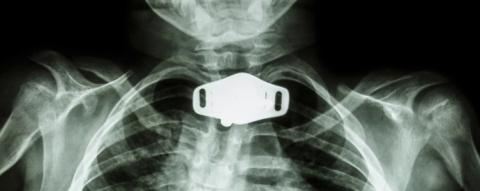
Permanent surgical solution needed to ensure adequate airway
As a result of intubation for several weeks early in his life, an infant developed subglottic stenosis and required a chronic tracheostomy to bypass the airway obstruction.
When the baby was 18 months old, his parents sought a surgeon who could help open the blockage, which would allow the tracheostomy to be removed permanently so that their child could live a normal life, free of the tracheostomy tube and associated risks and limitations on his activities.
The parents consulted with Jeffrey Cheng, MD, a Duke pediatric otolaryngologist who specializes in treating airway stenosis—one of the most complex and difficult challenges facing pediatric otolaryngologists.
Upon examining and evaluating the patient, Cheng determined that removing the tracheostomy would be possible but would require a complex surgical approach. “The baby had significant scarring in the area below his vocal cords,” says Cheng. “He needed a permanent surgical solution that would give him an adequate airway and hopefully allow for decannulation.”
Question: How was Cheng able to successfully clear the airway obstruction so that the patient could be decannulated?
View Case Conclusion
Answer: Cheng performed open laryngotracheal reconstruction, opening the neck to expose the airway then expanding the narrowed portion of the subglottic airway by using the child’s rib cartilage as grafts to expand the anterior and posterior area of the cricoid cartilage. He used a temporary breathing tube to hold the grafts in place and help heal and strengthen the area, and was able to successfully decannulate the patient.
The baby spent a week in the hospital postoperatively while Cheng performed a series of endoscopies to monitor the healing process. Now a healthy 2-year-old toddler, the patient has healed completely and is breathing comfortably without the tracheostomy.
Cheng is one of only a few surgeons in North Carolina with experience performing this type of complex airway reconstruction surgery on very young children and is a leading researcher in pediatric airway conditions, treatments, and risk factors. In a recent research study, he led a team that investigated predictors of adverse events for children undergoing laryngeal or tracheal dilation without prior tracheostomy placement.
Cheng is also currently working on innovative ways to treat airway stenosis in children. This research will allow otolaryngologists to identify areas for quality improvement of treatments and reductions in clinical risk factors that lead to complications following treatment, to help ensure the best clinical outcomes for children with airway stenosis.